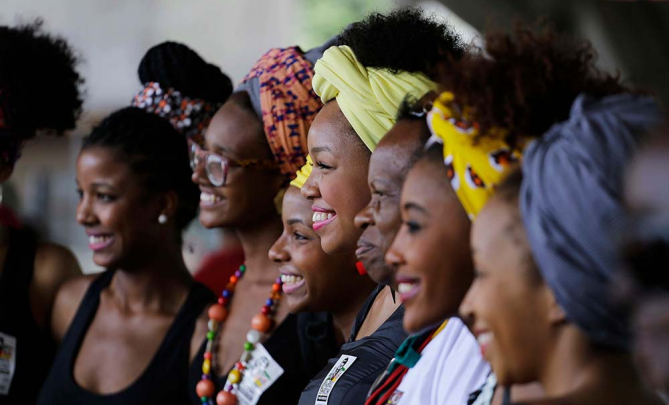Overview
The joint Staff Working Document on Objectives and Indicators to frame the implementation of the Gender Action Plan III (GAP III) complements the joint communication to the European Parliament and the Council – “Gender Action Plan III: an ambitious vision on gender equality and women’s empowerment for EU External action”, by providing a set of objectives and indicators to monitor progress in the implementation of GAP III and measure its results at country, regional and international levels.
Access the list of GAP III objectives and indicators (SWD2020 - 284 final) here
Part I – EU institutional and strategic objectives and indicators – focuses on the implementation of GAP III and presents for each objective a set of actions, indicators, baselines and targets. Data sources and actors are also indicated where possible. These indicators will be monitored on an annual basis. They will apply to the Commission services and the EEAS, covering interventions and actions at country, regional/multi-country, and international levels. Member States are invited to use them and report accordingly in order to strengthen joint efforts.
Part II – Objectives and indicators for GAP III thematic areas of engagement - - presents for each thematic area of GAP III a menu of objectives to be selected and used in different processes. For each objective, a set of ‘key thematic outcome indicators’ is highlighted. They will be integrated in the corporate monitoring system (OPSYS or equivalent) and used in priority to monitor results at country, regional and global levels in 2023 and 2025. Member States are encouraged to use the “key outcome indicators” in order to build aggregate reporting. See additional information in the Introduction to Part II.
Indicators in Part II include selected Sustainable Development Goals indicators, the thematic indicators of the Women Peace and Security action plan, other relevant regionally and internationally referenced indicators, including a selection taken from the Spotlight Initiative, and relevant indicators part of the European Union results framework. There are also selected qualitative indicators which seek to capture the hard-to-measure changes in social norms and attitudes and transformations in gender power relations.Overall the intention is to measure short to medium and longer-term progress on reaching GAP III objectives to which EU-funded interventions should contribute in collaboration with partner governments, civil society organisations and other funding providers. In line with the principles of aid effectiveness and effective development co-operation that put a strong focus on building partnerships and country ownership, Part II indicators should be reported on a “contribution basis”. This means that the reporting should cover overall results achieved jointly with our partners (including country governments), rather than just the results linked to the funding provided by the EU.
Each section presents a selection of ‘key thematic outcome indicators’ which will be included in the corporate monitoring systems - including in OPSYS and other relevant systems - and used for corporate and consolidated reporting. Their use is recommended when preparing country implementation plans and in programming. The set of ‘other thematic outcome indicators’ is meant to support intervention design and qualitative analysis. The list of ’key thematic outcome indicators’ might be updated including to take into account the 2021-2027 programming exercise.
Most of the indicators should be at least sex-disaggregated. Depending on national definitions, contexts, data collection capacity and “do no harm” approach, data should be broken down as a minimum by sex and age. Whenever relevant and feasible (i) sex-disaggregation should be replaced by gender-disaggregation and (ii) data should be disaggregated by other relevant intersectional aspects and indicators such as disability status, migrant status and rural-urban residence. Further guidance will be developed to support the correct use of the “key thematic outcome indicators”.
The EU action plan on Women, Peace and Security (2019-2024) - endorsed by the Council in July 2019 - is to be read in conjunction with the joint communication on GAP III and with this SWD. Joint reporting will be ensured to the extent possible, in line with respective reporting timelines and obligations. The mid-term and final review of the action plan on Women, Peace and Security should follow GAP III timeline.
GAP III Indicators - Methodological Notes
| Climate change and environment |
Fiche Indicator 1.1 Fiche Indicator 2.1 Fiche Indicator 2.2 Fiche Indicator 3.1 Fiche Indicator 3.2 Fiche Indicator 3.3 Fiche Indicator 4.1 Fiche Indicator 4.2 |
| Digitalisation |
Fiche Indicator 1.1 Fiche Indicator 1.2 Fiche Indicator 4.1 |
| Economic and social rights |
Fiche Indicator 1.2 Fiche Indicator 1.4 Fiche Indicator 2.1 Fiche Indicator 2.2 Fiche Indicator 2.3 Fiche Indicator 2.4 Fiche Indicator 3.2 Fiche Indicator 4.1 Fiche Indicator 4.2 Fiche Indicator 5.1 Fiche Indicator 5.2 Fiche Indicator 6.3 Fiche Indicator 6.5 Fiche Indicator 6.6 Fiche Indicator 7.1 Fiche Indicator 7.2 Fiche Indicator 8.3 Fiche other outcome indicator EDU 6.1 Fiche other outcome indicator EDU 6.4 Fiche other outcome indicator EDU 6.5 Fiche other outcome indicator EDU 6.6 Fiche other outcome indicator EDU 6.12 Fiche other outcome indicator EDU 6.14 |
| Gender-based violence (GBV) |
Fiche Indicator 2.1 Fiche Indicator 3.2 Fiche Indicator 3.3 Fiche Indicator 4.4 Fiche Indicator 5.1 Fiche Indicator 6.1 Fiche Indicator 6.2 Fiche Indicator 6.3 Fiche Indicator 8.1 Fiche Indicator 8.2 Fiche Indicator 8.3 |
| Participation and Leadership |
Fiche Indicator 1.1 Fiche Indicator 2.2 Fiche Indicator 3.3 Fiche Indicator 3.4 Fiche Indicator 4.1 Fiche Indicator 4.2 Fiche Indicator 4.3 Fiche Indicator 5.1 Fiche Indicator 5.2 |
| Sexual and Reproductive Health and Rights (SRHR) |
Fiche other outcome Indicator 1.1 Fiche other outcome Indicator 1.2 Fiche other outcome Indicator 1.4 Fiche other outcome Indicator 1.5 Fiche other outcome Indicator 2.1 Fiche other outcome Indicator 2.2
|
